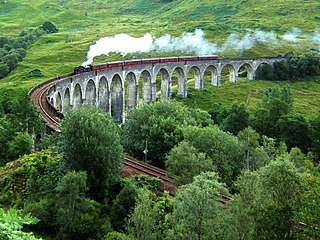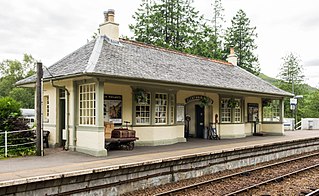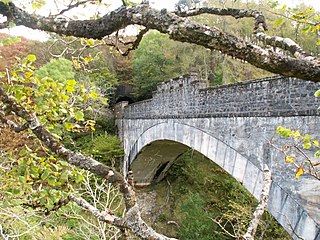
The Highland Railway (HR) was one of the smaller British railways before the Railways Act 1921, operating north of Perth railway station in Scotland and serving the farthest north of Britain. Based in Inverness, the company was formed by merger in 1865, absorbing over 249 miles (401 km) of line. It continued to expand, reaching Wick and Thurso in the north and Kyle of Lochalsh in the west, eventually serving the counties of Caithness, Sutherland, Ross & Cromarty, Inverness, Perth, Nairn, Moray and Banff. Southward it connected with the Caledonian Railway at Stanley Junction, north of Perth, and eastward with the Great North of Scotland Railway at Boat of Garten, Elgin, Keith and Portessie.

Glenfinnan is a hamlet in Lochaber area of the Highlands of Scotland. In 1745 the Jacobite rising began here when Prince Charles Edward Stuart raised his standard on the shores of Loch Shiel. Seventy years later, the 18 m (60 ft) Glenfinnan Monument, at the head of the loch, was erected to commemorate the historic event.

The Glenfinnan Viaduct is a railway viaduct on the West Highland Line in Glenfinnan, Inverness-shire, Scotland. Located at the top of Loch Shiel in the West Highlands of Scotland, the viaduct overlooks the Glenfinnan Monument and the waters of Loch Shiel.

Fort William railway station is a railway station serving the town of Fort William in the Highland region of Scotland.

Glenfinnan railway station is a railway station serving the village of Glenfinnan in the Highland council area of Scotland. It is on the West Highland Line. Glenfinnan Viaduct is about two-thirds of a mile (1.1 km) to the east of the station.

Mallaig railway station is a railway station serving the ferry port of Mallaig, Lochaber, in the Highland region of Scotland. This station is a terminus on the West Highland Line, 41 miles (66 km) by rail from Fort William and 164 miles (264 km) from Glasgow Queen Street railway station.
Fort William Junction is a railway junction on the West Highland Line in Scotland, located to the east of Fort William railway station. It is where the railway to Mallaig connects with the Glasgow to Fort William railway.

The Jacobite is a steam locomotive-hauled tourist train service that operates over part of the West Highland Railway Line in Scotland. It has been operating under various names and with different operators every summer since 1984. It has played an important role in sustaining a scenic route.
Events from the year 1901 in Scotland.

The Morar Railway Viaduct is a railway viaduct that carries the West Highland Line over the River Morar.

The Loch nan Uamh Viaduct is a railway viaduct that carries the West Highland Line.

The Borrodale Viaduct is a railway viaduct that carries the West Highland Line over the Borrodale Burn.

The Arnabol Viaduct carries the West Highland Line over the Arnabol Burn.

The Banavie Railway Swing Bridge carries the West Highland Line across the Caledonian Canal at Banavie.

Banavie Pier railway station was the terminus of a short branch and was at first known as Banvie, opened by the North British Railway in 1895. The station's location was just above the impressive flight of locks on the Caledonian Canal known as "Neptune's Staircase", Banavie, Highland council area, Scotland.
Inveruglas was a remote temporary private railway station near the hamlet of Inveruglas, Argyll and Bute, Scotland. Opened in 1945 by the LNER, it was built in connection with the construction of the Sloy Hydro-Electric facility and was located on the Ardlui side of the Inveruglas Viaduct and recorded to be out of use by around 1948.
Faslane Platform railway station or Faslane Junction Platform railway station was a temporary private railway station located near the Stuckendoff PoW camp, Shandon, Argyll and Bute, Scotland. Opened in 1945 by the LNER in connection with the construction of the Loch Sloy Hydro-Electric facility and was located on the Shandon side of the Chapel Burn and recorded to be out of use by around 1949 in the British Railways era.



















